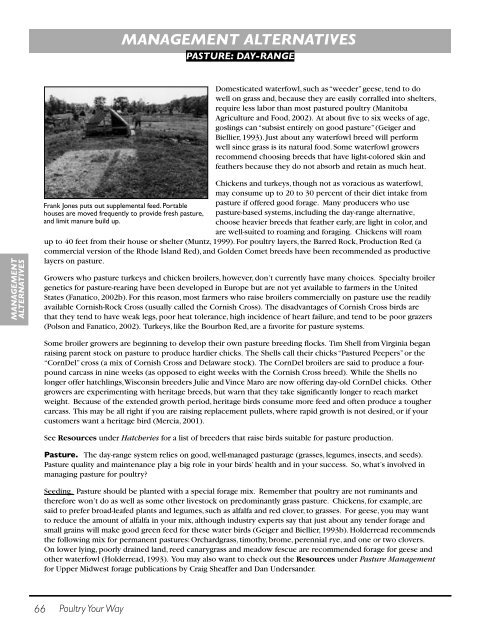Poultry Your Way - Center for Integrated Agricultural Systems ...
Poultry Your Way - Center for Integrated Agricultural Systems ...
Poultry Your Way - Center for Integrated Agricultural Systems ...
Create successful ePaper yourself
Turn your PDF publications into a flip-book with our unique Google optimized e-Paper software.
MANAGEMENT<br />
ALTERNATIVES<br />
66<br />
<strong>Poultry</strong> <strong>Your</strong> <strong>Way</strong><br />
MANAGEMENT ALTERNATIVES<br />
PASTURE: DAY-RANGE<br />
Frank Jones puts out supplemental feed. Portable<br />
houses are moved frequently to provide fresh pasture,<br />
and limit manure build up.<br />
Domesticated waterfowl, such as “weeder” geese, tend to do<br />
well on grass and, because they are easily corralled into shelters,<br />
require less labor than most pastured poultry (Manitoba<br />
Agriculture and Food, 2002). At about five to six weeks of age,<br />
goslings can “subsist entirely on good pasture” (Geiger and<br />
Biellier, 1993). Just about any waterfowl breed will per<strong>for</strong>m<br />
well since grass is its natural food. Some waterfowl growers<br />
recommend choosing breeds that have light-colored skin and<br />
feathers because they do not absorb and retain as much heat.<br />
Chickens and turkeys, though not as voracious as waterfowl,<br />
may consume up to 20 to 30 percent of their diet intake from<br />
pasture if offered good <strong>for</strong>age. Many producers who use<br />
pasture-based systems, including the day-range alternative,<br />
choose heavier breeds that feather early, are light in color, and<br />
are well-suited to roaming and <strong>for</strong>aging. Chickens will roam<br />
up to 40 feet from their house or shelter (Muntz, 1999). For poultry layers, the Barred Rock, Production Red (a<br />
commercial version of the Rhode Island Red), and Golden Comet breeds have been recommended as productive<br />
layers on pasture.<br />
Growers who pasture turkeys and chicken broilers, however, don’t currently have many choices. Specialty broiler<br />
genetics <strong>for</strong> pasture-rearing have been developed in Europe but are not yet available to farmers in the United<br />
States (Fanatico, 2002b). For this reason, most farmers who raise broilers commercially on pasture use the readily<br />
available Cornish-Rock Cross (usually called the Cornish Cross). The disadvantages of Cornish Cross birds are<br />
that they tend to have weak legs, poor heat tolerance, high incidence of heart failure, and tend to be poor grazers<br />
(Polson and Fanatico, 2002). Turkeys, like the Bourbon Red, are a favorite <strong>for</strong> pasture systems.<br />
Some broiler growers are beginning to develop their own pasture breeding flocks. Tim Shell from Virginia began<br />
raising parent stock on pasture to produce hardier chicks. The Shells call their chicks “Pastured Peepers” or the<br />
“CornDel” cross (a mix of Cornish Cross and Delaware stock). The CornDel broilers are said to produce a fourpound<br />
carcass in nine weeks (as opposed to eight weeks with the Cornish Cross breed). While the Shells no<br />
longer offer hatchlings, Wisconsin breeders Julie and Vince Maro are now offering day-old CornDel chicks. Other<br />
growers are experimenting with heritage breeds, but warn that they take significantly longer to reach market<br />
weight. Because of the extended growth period, heritage birds consume more feed and often produce a tougher<br />
carcass. This may be all right if you are raising replacement pullets, where rapid growth is not desired, or if your<br />
customers want a heritage bird (Mercia, 2001).<br />
See Resources under Hatcheries <strong>for</strong> a list of breeders that raise birds suitable <strong>for</strong> pasture production.<br />
Pasture. The day-range system relies on good, well-managed pasturage (grasses, legumes, insects, and seeds).<br />
Pasture quality and maintenance play a big role in your birds’ health and in your success. So, what’s involved in<br />
managing pasture <strong>for</strong> poultry?<br />
Seeding. Pasture should be planted with a special <strong>for</strong>age mix. Remember that poultry are not ruminants and<br />
there<strong>for</strong>e won’t do as well as some other livestock on predominantly grass pasture. Chickens, <strong>for</strong> example, are<br />
said to prefer broad-leafed plants and legumes, such as alfalfa and red clover, to grasses. For geese, you may want<br />
to reduce the amount of alfalfa in your mix, although industry experts say that just about any tender <strong>for</strong>age and<br />
small grains will make good green feed <strong>for</strong> these water birds (Geiger and Biellier, 1993b). Holderread recommends<br />
the following mix <strong>for</strong> permanent pastures: Orchardgrass, timothy, brome, perennial rye, and one or two clovers.<br />
On lower lying, poorly drained land, reed canarygrass and meadow fescue are recommended <strong>for</strong>age <strong>for</strong> geese and<br />
other waterfowl (Holderread, 1993). You may also want to check out the Resources under Pasture Management<br />
<strong>for</strong> Upper Midwest <strong>for</strong>age publications by Craig Sheaffer and Dan Undersander.

















